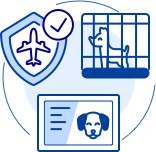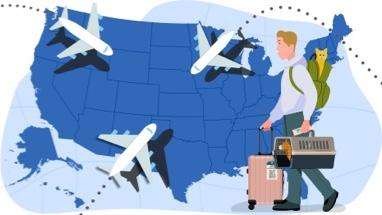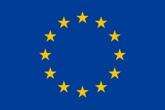Pet Travel From the United States to Australia
Travel Requirements Based on Pet Type
Carefully read ALL of the requirements related to your pet on this page.
- This page provides the most recent entry requirements and can change without notice.
- It is the responsibility of the veterinarian to make sure the pet has met all health requirements of the destination country before issuing a health certificate.
- Failure to meet the requirements may result in problems gaining certificate endorsement or difficulties upon arrival in the destination country.
- Health certificates must be legible, accurate, and complete.
For dogs and cats traveling from other countries to the United States and then to Australia, read this guidance (108.46 KB) first.
Read and follow Australia's step-by-step guides for dogs and cats:
More Guidance
The following information clarifies certain requirements outlined in Australia’s step-by-step guides. Please read it carefully.
The veterinarian(s) who prepares the pet for export to Australia (includes scanning the microchip, drawing blood, completing the laboratory submission forms, etc.) must be a USDA-accredited veterinarian in the State where they perform work.
Pet Owners—Find an Accredited Veterinarian
Check Accreditation Status (Veterinarians Only)
Pets that complete this identity check will be eligible for 10 days in post-entry quarantine upon arrival into Australia. If you cannot fully meet this identity check process as outlined, the pet will need to spend 30 days in post-entry quarantine upon arrival in Australia.
Follow the instructions below (steps 1–12) to have your pet's identity verified.
There are multiple fees for this service, as noted below.
Identity declarations are valid for as long as the animal:
- can be identified by the verified microchip on the declaration, and
- resides in an approved country.
Part 1
- Take your pet to a USDA-accredited veterinarian and have them complete the identity declaration (324.71 KB).
- The veterinarian may complete the declaration directly within VEHCS. They do not need to fill out the PDF version.
- The accredited veterinarian must take a color photo(s) of the pet and the microchip scanner with the microchip number visible.
- At least one photo should have both the scanner, with the microchip number visible, and at least a significant portion of the pet together in the same photo.
- The accredited veterinarian must use VEHCS to submit the identity declaration and photo(s) to USDA for endorsement.
- A user fee to USDA is required for the endorsement of the declaration.
- In VEHCS, click "New Certificate."
- For "Destination Country," select “Australia.”
- For "Commodity Type," select “Dogs & cats - ID declaration part 1 or 2.”
- VEHCS will generate the certificate. The veterinarian does not need to fill out the PDF form before going to VEHCS.
- On the "Attachments" screen, upload the photo(s).
- After the accredited veterinarian submits the identity declaration and photo(s) in VEHCS, USDA will review and endorse. The accredited veterinarian must provide the endorsed certificate number to you (the pet owner/exporter).
Part 2
- After completing steps 1–4 in Part 1, you must take your pet to a different USDA-accredited veterinarian at a different veterinary clinic and have them complete a new identity declaration (324.71 KB).
- The veterinarian may complete the declaration directly within VEHCS. They do not need to fill out the PDF version.
- The two accredited veterinarians should work at different clinics.
- The second accredited veterinarian must take a color photo(s) of the pet and the microchip scanner with the microchip number visible.
- At least one photo should have both the scanner, with the microchip number visible, and at least a significant portion of the pet together in the same photo.
- The second accredited veterinarian must use VEHCS to submit the identity declaration and photo(s) to USDA for endorsement.
- A user fee to USDA is required for the endorsement of the declaration.
- In VEHCS, click "New Certificate."
- For "Destination Country," select “Australia.”
- For "Commodity Type," select “Dogs & cats - ID declaration part 1 or 2.”
- VEHCS will generate the certificate. The veterinarian does not need to fill out the PDF form before going to VEHCS.
- On the "Attachments" screen, upload the photo(s).
- After the accredited veterinarian submits the identity declaration and photo(s) in VEHCS, USDA will review and endorse. The accredited veterinarian must provide the endorsed certificate number to you (the pet owner/exporter).
Blood cannot be drawn for the rabies neutralizing antibody titer test (RNATT) until after the date of the second microchip scanning (can be done on same day). Part 3 below MUST still be completed by the accredited veterinarian.
Part 3
Part 3 must be endorsed within 3 months of the date of the first microchip scanning. Please submit requests in a timely manner.
- One of the accredited veterinarians must then logon to VEHCS and submit a request for completion of the USDA identity declaration (required by Australia) by uploading a completed request form (126.07 KB). The exporter must provide the veterinarian with the VEHCS endorsed certificate number for both accredited veterinarian declarations that were completed.
- A user fee to USDA is required for the endorsement of the declaration.
- In VEHCS, click "New Certificate."
- For “Destination Country,” select “Australia.”
- For “Commodity Type,” select “Commodity not listed.”
- Click the “Next” button, and then for “Commodity Type,” select “Dogs & cats - final ID declaration part 3.”
- On the “Upload PDF” screen, upload the completed request form.
- After the request is submitted, USDA will complete a separate identity declaration, based on the information provided by the two accredited veterinarians in the first and second accredited veterinarian identity declarations. USDA will upload the endorsed USDA identity declaration in VEHCS and email it directly to Australia.
- Once the USDA identity declaration certificate is marked "Completed" in VEHCS, you/the exporter may then proceed to the next step in Australia’s step-by-step guide for dogs or cats.
- You must retain a copy of the endorsed USDA identity declaration to attach to the export health certificate that must accompany the pet during travel to Australia.
Follow step 4 in Australia’s step-by-step guide for dogs or cats to complete the rabies neutralizing antibody titer test (RNATT) and RNATT Declaration (270.64 KB).
A USDA-accredited veterinarian must scan the pet's microchip (dogs and cats) and collect the blood sample for the RNATT. The USDA-accredited veterinarian that drew the blood must complete the laboratory submission form, including the animal's microchip number and the blood sampling date.
Once you receive the RNATT laboratory report, you need to obtain an endorsed RNATT Declaration (270.64 KB) from USDA. We strongly recommend that the pet’s USDA-accredited veterinarian use VEHCS to request the RNATT Declaration. You must retain a copy of the endorsed RNATT Declaration to attach to the export health certificate that must accompany the pet during travel to Australia.
- In VEHCS, click "New Certificate."
- For “Destination Country,” select “Australia.”
- For “Commodity Type,” select "Commodity not listed."
- Click the “Next” button, and then for “Commodity Type,” select “Dogs and cats - RNATT Declaration for Australia.”
- On the “Upload PDF” screen, upload a blank RNATT declaration for USDA to complete.
- On the "Attachments" screen, upload the RNATT laboratory report and rabies vaccination certificate.
The dog or cat is only eligible for export to Australia at least 180 days after the blood sample arrives at the laboratory for the RNATT. You can find more information about the waiting period on your import permit issued by Australia.
Australia requires intact dogs to be tested for Brucella canis, using one of the following test types (listed on the export health certificate):
- RSAT
- TAT
- IFAT
Only the standard versions of the tests listed above will be accepted.
The following tests are not approved:
- 2ME-RSAT
- 2ME-TAT
- AGID/AGID II
- Canine Brucella Multiplex Assay
- Brucella Slide Agglutination/AGID II combination test
We strongly recommend that USDA-accredited veterinarians use VEHCS to complete the export health certificate for submission to USDA. USDA must endorse the export health certificate. Find a USDA endorsement office.
- When creating the certificate in VEHCS:
- For "Destination Country," select “Australia.”
- For "Commodity Type," select either “Dog from U.S. States (except Hawaii and Guam)” or “Cat from U.S. States (except Hawaii and Guam).”
- The USDA-accredited veterinarian must use the health certificate available in VEHCS or the applicable health certificate listed below (the veterinarian may navigate directly to VEHCS without downloading this PDF). The health certificate provided in the Australian-issued import permit is not specific for pets from the United States.
- Dog from U.S. States (except Hawaii and Guam) (306.68 KB)
- Cat from U.S. States (except Hawaii and Guam) (229.82 KB)
- Leptospirosis vaccination section on new model health certificate:
- If the pet received a primary course (two vaccinations) before export, the accredited veterinarian must record the details of both vaccinations on the health certificate.
- If the pet received an annual booster before export, the accredited veterinarian must record the details of that vaccination and the details of the last vaccination given before the booster.
Read and follow Australia's step-by-step guides for dogs and cats:
More Guidance
The following information clarifies certain requirements outlined in Australia’s step-by-step guides. Please read it carefully.
The veterinarian(s) who prepares the pet for export to Australia (includes scanning the microchip, drawing blood, completing the laboratory submission forms, etc.) must be a USDA-accredited veterinarian in the State where they perform work.
Pet Owners—Find an Accredited Veterinarian
Check Accreditation Status (Veterinarians Only)
Pets from Hawaii and Guam must fully complete the identity check process to export to Australia under the Category 2 import conditions. If you cannot complete the identity check process, contact Australia's Department of Agriculture, Fisheries and Forestry at imports@agriculture.gov.au for advice before proceeding with any other steps.
Follow the instructions below (steps 1–12) to have your pet's identity verified.
There are multiple fees for this service, as noted below.
Identity declarations are valid for as long as the animal:
- can be identified by the verified microchip on the declaration, and
- resides in a group 1 or group 2 approved country.
Part 1
- Take your pet to a USDA-accredited veterinarian and have them complete the identity declaration (324.71 KB).
- The veterinarian may complete the declaration directly within VEHCS. They do not need to fill out the PDF version.
- The accredited veterinarian must take a color photo(s) of the pet and the microchip scanner with the microchip number visible.
- At least one photo should have both the scanner, with the microchip number visible, and at least a significant portion of the pet together in the same photo.
- The accredited veterinarian must use VEHCS to submit the identity declaration and photo(s) to USDA for endorsement.
- A user fee to USDA is required for the endorsement of the declaration.
- In VEHCS, click "New Certificate."
- After the accredited veterinarian submits the identity declaration and photo(s) in VEHCS, USDA will review and endorse. The accredited veterinarian must provide the endorsed certificate number to you (the pet owner/exporter).
Part 2
- After completing steps 1–4 in Part 1, you must take your pet to a different USDA-accredited veterinarian at a different veterinary clinic and have them complete a new identity declaration (324.71 KB).
- The veterinarian may complete the declaration directly within VEHCS. They do not need to fill out the PDF version.
- The two accredited veterinarians should work at different clinics.
- The second accredited veterinarian must take a color photo(s) of the pet and the microchip scanner with the microchip number visible.
- At least one photo should have both the scanner, with the microchip number visible, and at least a significant portion of the pet together in the same photo.
- The second accredited veterinarian must use VEHCS to submit the identity declaration and photo(s) to USDA for endorsement.
- A user fee to USDA is required for the endorsement of the declaration.
- In VEHCS, click "New Certificate."
- For “Destination Country,” select “Australia.”
- For “Commodity Type,” select “Dogs & cats - ID declaration part 1 or 2.”
- VEHCS will generate the certificate. The veterinarian does not need to fill out the PDF form before going to VEHCS.
- On the “Attachments screen,” upload the photo(s).
- After the accredited veterinarian submits the identity declaration and photo(s) in VEHCS, USDA will review and endorse. The accredited veterinarian must provide the endorsed certificate number to you (the pet owner/exporter).
Part 3 below MUST still be completed by the accredited veterinarian.
Part 3
Part 3 must be endorsed within 3 months of the date of the first microchip scanning. Please submit requests in a timely manner.
- One of the accredited veterinarians must then logon to VEHCS and submit a request for completion of the USDA identity declaration (required by Australia) by uploading a completed request form (126.07 KB). The exporter must provide the veterinarian with the VEHCS endorsed certificate number for both accredited veterinarian declarations that were completed.
- A user fee to USDA is required for the endorsement of the declaration.
- In VEHCS, click "New Certificate."
- For "Destination Country," select “Australia.”
- For "Commodity Type," select “Commodity not listed.”
- Click the "Next" button, and then for "Commodity Type," select “Dogs & cats - final ID declaration part 3.”
- On the "Upload PDF" screen, upload the completed request form.
- After the request is submitted, USDA will complete a separate identity declaration, based on the information provided by the two accredited veterinarians in the first and second accredited veterinarian identity declarations. USDA will upload the endorsed USDA identity declaration in VEHCS and email it directly to Australia.
- Once the USDA identity declaration certificate is marked "Completed" in VEHCS, you/the exporter may then proceed to the next step in Australia’s step-by-step guide for dogs or cats.
- You must retain a copy of the endorsed USDA identity declaration to attach to the export health certificate that must accompany the pet during travel to Australia.
Australia requires intact dogs to be tested for Brucella canis, using one of the following test types (listed on the export health certificate):
- RSAT
- TAT
- IFAT
Only the standard versions of the tests listed above will be accepted.
The following tests are not approved:
- 2ME-RSAT
- 2ME-TAT
- AGID/AGID II
- Canine Brucella Multiplex Assay
- Brucella Slide Agglutination/AGID II combination test
Regarding Crate Seal: Before submitting the health certificate to USDA for endorsement, the pet's veterinarian must contact the USDA endorsement office to obtain an official seal, which must be placed on the pet's crate on the day of departure. The pet's veterinarian must record the seal number on the health certificate before submitting it to USDA.
We strongly recommend that USDA-accredited veterinarians use VEHCS to complete the export health certificate for submission to USDA. USDA must endorse the export health certificate. Find a USDA endorsement office.
- When creating the certificate in VEHCS:
- For "Destination Country," select “Australia.”
- For "Commodity Type," select either “Dog from Hawaii or Guam” or “Cat from Hawaii or Guam.”
- The accredited veterinarian must use the health certificate available in VEHCS or the applicable health certificate listed below (the veterinarian may navigate directly to VEHCS without downloading this PDF). The health certificate provided in the Australian-issued import permit is not specific for pets from the United States.
- Dog from Hawaii or Guam (1.23 MB)
- Cat from Hawaii or Guam (250.89 KB)
- Leptospirosis vaccination section on new model health certificate:
- If the pet received a primary course (two vaccinations) before export, the accredited veterinarian must record the details of both vaccinations on the health certificate.
- If the pet received an annual booster before export, the accredited veterinarian must record the details of that vaccination and the details of the last vaccination given before the booster.
For pet travel requirements not listed, APHIS has not been officially informed by the foreign country about the requirements for your pet’s travel. We recommend that you contact a government official of the country you are traveling to for more information.
Country of Destination Contact Information
Countries Participating in the European Union
Austria
Belgium
Bulgaria
Croatia
Cyprus
Czech Republic
Denmark
Estonia
Finland
France
Germany
Greece
Hungary
Republic of Ireland
Italy
Latvia
Lithuania
Luxembourg
Malta
Netherlands
Northern Ireland*
Norway**
Poland
Portugal
Romania
Slovakia
Slovenia
Spain
Sweden
Switzerland**
* Northern Ireland is part of the United Kingdom (UK), but will continue to follow European Union (EU) requirements even though the UK is no longer part of the EU.
** Norway and Switzerland are not part of the EU but have adopted EU legislation for import of most species of live animals.
Need Help?
Still Have Questions?
USDA-Accredited Veterinarians
Contact a USDA-accredited veterinarian for questions about your destination country's entry requirements for pets (including any needed vaccinations, tests, or treatments) and for issuance of health certificates.
Find a USDA-Accredited Veterinarian
USDA Endorsement Offices
Contact your nearest APHIS Veterinary Export Trade Services Endorsement Office for questions about endorsing a health certificate for pets.
For VEHCS help see the VEHCS help page. Routine APHIS VEHCS processing services are staffed Monday through Friday from 7:00 AM to 4:30 PM Central Time (CT) excluding federal holidays, the time listed in VEHCS reflects GMT.
Looking for Another Country?
Find your destination country requirements by using the dropdown menu below. If your country is not listed in the menu, visit Pet Travel: Unknown Requirements.




